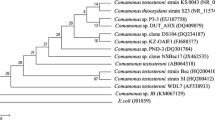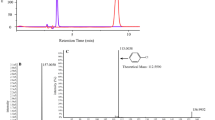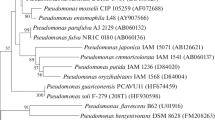Abstract
A 4-chlorophenol (4-CP)-degrading bacterium, strain CPW301, was isolated from soil and identified as Comamonas testosteroni. This strain dechlorinated and degraded 4-CP via a meta-cleavage pathway. CPW301 could also utilize phenol as a carbon and energy source without the accumulation of any metabolites via the same meta-cleavage pathway. When phenol was added as a additional substrate, CPW301 could degrade 4-CP and phenol simultaneously. The addition of phenol greatly accelerated the degradation of 4-CP due to the increased cell mass. The simultaneous degradation of the 4-CP and phenol is useful not only for enhanced cell growth but also for the bioremediation of both compounds, which are normally present in hazardous waste sites as a mixture.
Similar content being viewed by others
References
Arensdorf, JJ & Focht, DD (1995) A meta-cleavage pathway for 4-chlorobenoate, an intermediate in the metabolism of 4-chlorobiphenyl by Pseudomonas cepacia P166. Appl. Environ. Microbiol. 61: 443–447
Asturias, JA & Timmis, KN (1993) Three different 2,3-dihydroxybiphenyl-1,2-dioxygenase genes in the gram-positive polychlorobiphenyl-degrading bacterium Rhodococcus globerulus P6. J. Bacteriol. 175: 4631–4640
Balfanz, J & Rehm, H-J (1991) Biodegradation of 4-chlorophenol by adsorptive immobilized Alcaligenes sp. A7–2 in soil. Appl. Microbiol. Biotechnol. 35: 662–668
Bartels, I, Knackmuss, H-J & Reineke, W (1984) Suicide inactivation of catechol 2,3-dioxygenase from Pseudomonas putida mt-2 by 3-chlorocatechols. Appl. Environ. Microbiol. 47: 500–505
Boyd, SA & Shelton, DR (1984) Anaerobic biodegradation of chlorophenols in fresh and acclimated sludge. Appl. Environ. Microbiol. 47: 272–277
Cole, JR, Cascarelli, AL, Mohn, WW & Tiedje, JM (1994) Isolation and characterization of a novel bacterium growing via reductive dehalogenation of 2-chlorophenol. Appl. Environ. Microbiol. 60: 3536–3542
Dorn, E & Knackmuss, H-J (1978) Chemical structure and biodegradability of halogenated aromatic compounds; substituent effects on 1,2-dioxygenation of catechol. Biochem. J. 174: 85–94
Hollender, J, Dott, W & Hopp, J (1994) Regulation of chloro- and methylphenol degradation in Comamonas testosteroni JH5. Appl. Environ. Microbiol. 60: 2330–2338
Feist, CF & Hegeman, GD (1969) Phenol and benzoate metabolism by Pseudomonas putida: regulation of tangential pathway. J. Bacteriol. 100: 869–877
Knackmuss, H-J & Hellwig, M (1978) Utilization and cooxidation of chlorinated phenols by Pseudomonas sp. B13. Arch. Microbiol. 117: 1–7
Lee, S-T, Lee, S-B & Park, Y-H (1991) Characterization of a pyridinedegrading branched gram-positive bacterium isolated from the anoxic zone of an oil shale column. Appl. Microbiol. Biotechnol. 35: 824–829
Lowry, OH, Rosebrough, NJ, Farr, AL & Randall, RJ (1951) Protein measurement with the Folin phenol reagent. J. Biol. Chem. 193: 265–275
Madsen, T & Aamand, J (1992) Anaerobic transformation and toxicity of trichlorophenols in a stable enrichment culture. Appl. Environ. Microbiol. 58: 557–561
Menke, B & Rehm, H-J (1992) Degradation of mixtures of monochlorophenols and phenol as substrates for free and immobilized cells of Alcaligenes sp. A7–2. Appl. Microbiol. Biotechnol. 37: 655–661
Mikesell, MD & Boyd, SA (1986) Complete reductive dechlorination and mineralization of pentachlorophenol by anaerobic microorganisms. Appl. Environ. Microbiol. 52: 861–865
Murray, K, Duggleby, CJ, Sala-Trepat, JM & Williams, PA (1972) The metabolism of benzoate and methylbenzoates via the meta-cleavage pathway by Pseudomonas arvilla mt-2. Eur. J Biochem. 28: 301–310
Smibert, RM & Krieg, NR (1981) General characterization. In: Gerhardt, P, Murry, RGE, Costilow, R, Nester, E, Wood, WA, Krier, NR & Phillips, GB (Eds) Manual of Methods for General Bacteriology (pp 411–423). American Society for Microbiology, Washington, DC
Sondossi, M, Sylvestre, M & Ahmad, D (1992) Effects of chlorobenzoate transformation on the Pseudomonas testosteroni biphenyl and chlorobiphenyl degradation pathway. Appl. Environ. Microbiol. 58: 485–495
Tamaoka, J & Komagata, K (1984) Determination of DNA base composition by reverse-phase high-performance liquid chromatograph. FEMS Microbiol. Lett. 25: 125–128
Tamaoka, J, Ha, D-M & Komagata, K (1987) Reclassification of Pseudomonas acidovorans den Dooren de Jong 1926 and Pseudomonas testosteroni Marcus and Talalay 1956 as Comamonas testosteroi comb. nov., with an emended description of the genus Comamonas. Int. J. Syst. Bacteriol. 37: 52–59
Westmeier, F & Rehm, H-J (1987) Degradation of 4-chlorophenol in municipal wastewater by adsorptive immobilized Alcaligenes sp. A 7–2. Appl. Microbiol. Biotechnol. 26: 78–83
Wieser, M, Ebenspächer, J, Vogler, B & Lingens, F (1994) Metabolism of 4-chlorophenol by Azobacter sp. GP1: structure of the meta cleavage product of 4-chlorocatechol. FEMS Microbiol. Lett. 116: 73–78
Woods, SL, Ferguson, JF & Benjamin, MM (1989) Characterization of chlorophenol and chloromethoxybenzene biodegradation during anaerobic treatment. Environ. Sci. Technol. 23: 62–68
Author information
Authors and Affiliations
Rights and permissions
About this article
Cite this article
Bae, H.S., Lee, J.M., Kim, Y.B. et al. Biodegradation of the mixtures of 4-chlorophenol and phenol by Comamonas testosteroni CPW301. Biodegradation 7, 463–469 (1996). https://doi.org/10.1007/BF00115293
Accepted:
Issue Date:
DOI: https://doi.org/10.1007/BF00115293




